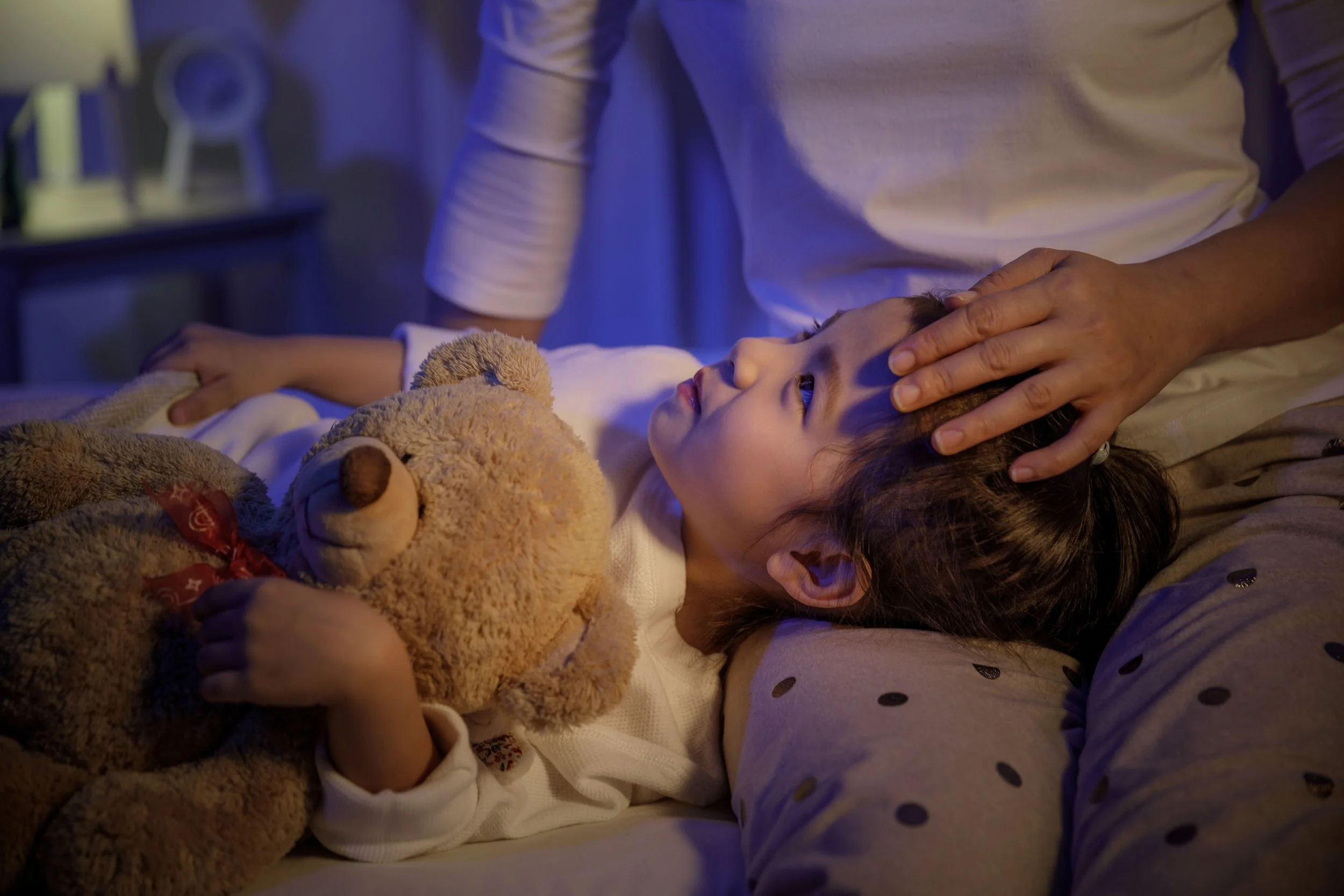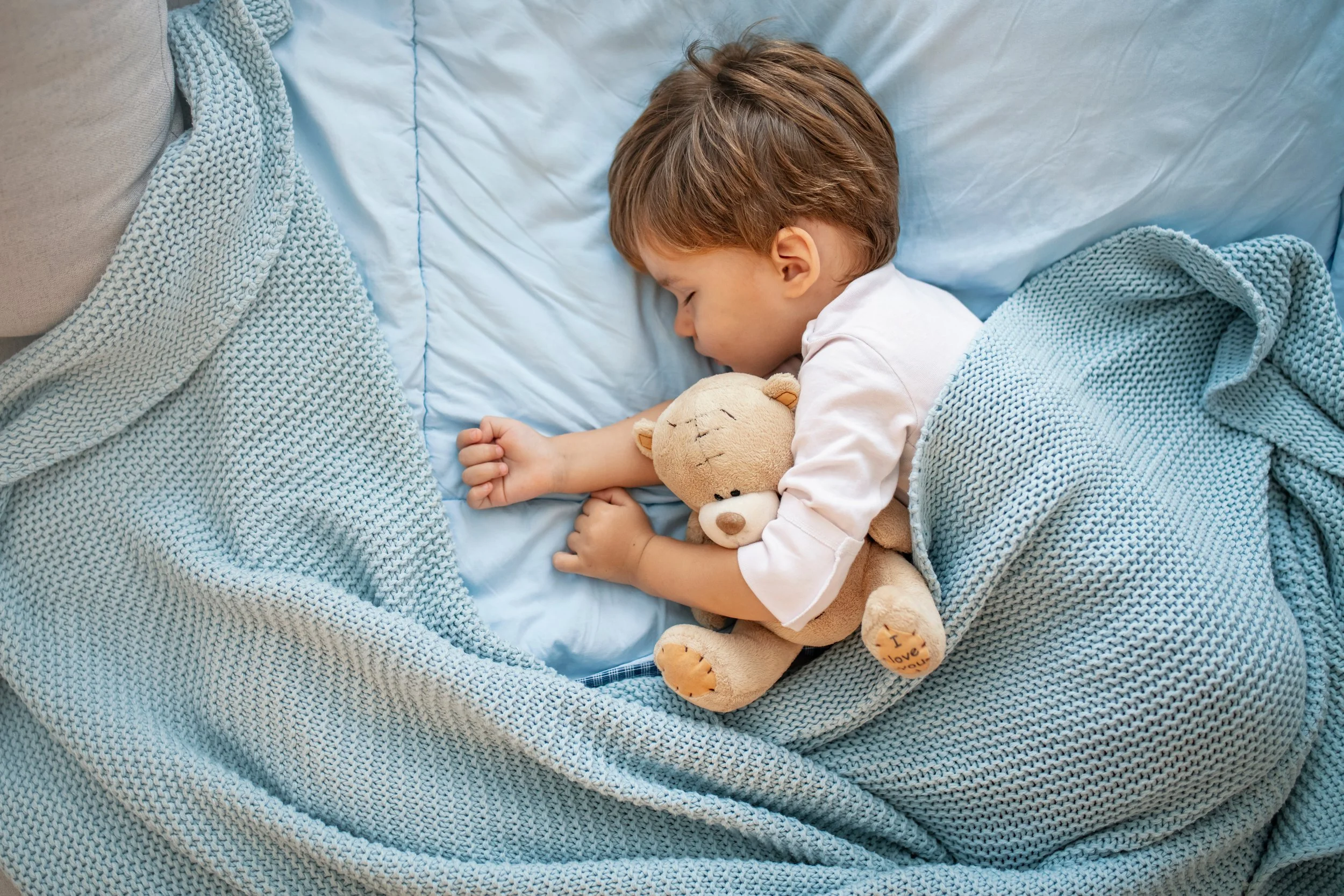Let’s talk about separation anxiety and sleep. You know the scenario: Everything is going great; your child is in that perfect sleepy sweet spot and the bedtime routine has been on point. Then suddenly:
I don’t want to go to bed!
I don’t want you to leave!
One more back rub!
More water!
I need to go POTTY!!!
Fast forward to 3:00 AM — your family is fast asleep, you’re dreaming heavily of the white sands of French Polynesia, then you’re jarred out of your island paradise from the hysterical screams of:
DADAAAAAAAAAA!!!
What is going on with your perfect little cherub child? They were just fine 7 hours ago! What the heck happened?
While there could be a number of things at play (including boundary testing), I want to cover some ways you can help get your child to a place of calm so that they aren’t always needing you to do the calming for them.
In this post, I explain why separation anxiety at bedtime is so hard and provide you with several methods to address the stress so that when nighttime struggles present themselves, you have technique to lean on.
Relaxation Techniques for Easing Separation Anxiety at Bedtime
By Marian van Noppen, SENIOR SLEEP Consultant
Understanding Nighttime Anxiety
Identifying where the fear stems from helps us know how to address it. One thing that it comes down to is the simple fact that the stretch of time between going to sleep at bedtime and waking up in the morning is essentially the longest stretch of time we ask children to be away from us — alone. They may still be under the same roof, but they’re in their own space on their own (at least in their view). So if they are experiencing some separation struggles, we want to help make the gap smaller between us and them that is required of them for sleep.
How to Lessen the Sleep Separation Gap
There are a few ways we can do this:
We can teach our children relaxation techniques they can depend on when they are feeling stressed
We can infuse our presence into our child’s bedroom
We can approach bedtime with supportive and empathetic ways first and then allow more and more distance as our child gains trust in the process
Relaxation Techniques for Children
The Sleep Mantra
One of the first pieces of homework that I give my clients is to come up with a “key sleep phrase”, or you might call it a “sleep mantra”, if they don’t have one already.
It should be something that any caregiver can say to the child that will cue them that it's time to relax and go to sleep. I have clients who, later down the road, can say this phrase and their child immediately relaxes and knows it’s time for sleep. That’s what we’re aiming for in the long term with this phrase.
— Rules of the Mantra —
Rule #1
Keep It Simple
You can embellish the sleep phrase when you're saying it to your child on your own — you can add those "I love you"’s and "You're the best"’s and all of those sweet things — but you really want to keep it simple. A good key phrase may be something like, “I am safe. I am protected. I will see mommy and daddy in the morning,” or, "It's time for sleep. I wish for sweet dreams. I love my bed."
Rule #2
Practice Day and Night
This is SO important! Practice saying the phrase with your child over and over and over and over so that it becomes second nature to them. So come up with a sleep mantra that you and your child love and any caregiver can say and practice that sleep mantra over and over and over again — not just at bedtime. You also want to say it at nap time, too. You want to say it for all sleep situations so that we're really instilling that this is the cue for sleep. Practice on the way to school! Practice at lunch!
"I know we're having lunch, but I really love your sleep phrase. I want to say it. Let's say it real quick. Do you wanna say it? You don't want to say it. Okay. Well, I'm just going to say it, ‘It's time for sleep. I wish for sweet dreams. I love my bed.'"
You’re saying it even when your child doesn’t want to participate because believe it or not, those words are getting through. Do this over and over and over and eventually, it will become part of your child's vocabulary.
Recording the MantrA: The Sleep Button
Right in line with the sleep phrase is one effective device you can set up: a sleep button.
You can record your sleep phrase onto this button, and when your child wakes up in the night and they want to hear your voice saying the phrase and providing that security to them, they can press the button. This gives them agency over something in their room that not only implements the sleep phrase — the cueing sign for sleep — but it infuses you into their space. You can actually put the button onto their crib or their bed, if you wish, with double sided gorilla tape, or if they have a little table beside them, you can put it on the table, anywhere they can reach. Let your child press the button however many times as they like so they feel the vibration of sound soothing them.
To introduce the button (especially if your child is on the younger toddler side), you can practice pressing the button together at bedtime so they start to understand the concept.
"Okay, if you wake up in the night, and you want to call out for me, the first thing I want you to do is reach for your button. Press your button, and my voice will be there, and I want you to say the phrase with me and your button, okay? 'It's time for sleep. I wish for sweet dreams. I love my bed.' Okay. Now can I see you press the button? Let's do it together."
Then you can practice having your child press the button and saying the phrase together and solo. You can do it over and over and over. Then during the bedtime routine, you can press the button and say the phrase with the button every time that you’d say the key phrase. This way, you're teaching your child that it's okay to press the button, the button is not scary and the button is a safety tool.
The Night Light
Incorporate a Night Light (at the Appropriate Age)
Until a child verbally expresses a fear of the dark (the earliest I've seen this with my clients has been around 2½ years old), they really don't need a night light. A young child’s pupil to oculus ratio is much larger than ours so they take in a ton of light in the dark. Therefore, you really want their room pitch black so that they're not picking up on any external light, whether that's light leakage from early morning light or street lights, or LEDs that may be illuminated from an air conditioner, humidifier, or a monitor. If you have those LED lights on, I would definitely get little blackout stickers to block those lights out. Otherwise, the light will just trigger the child’s eyes to send a signal to the brain to tell their system to produce cortisol and keep them awake. This can also lead to night wakings and it can lead to night terrors. So definitely check the light in the room. But once a child expresses a fear of the dark, you can put a nightlight in the room, just make sure that it is amber, red, or pink-toned, as those colors are conducive to sleep.
Once your kiddo makes that transition to the big kid bed after three years old (hopefully no sooner!), you can keep their door cracked and keep the hall light on, which will help keep that thread to you alive and help them feel a sense of security and safety.
Birthday Candle Breaths
You can also start teaching your child deep breathing at a young age. Some people call them hot chocolate breaths, some people call them birthday candle breaths, some call them dandelion breaths. Whatever you decide, the technique is the same.
“I want to try this special breathing. Let me show you what you do. Do you want to do it with me? Let’s imagine we have a big birthday cake. Do you see it? I see it too! It has 3 candles on it for you. Let’s take a deep breath and let's blow the birthday candles out. Don't blow too hard or the birthday candles will fall over. Did you get all the birthday candles? Good job. Oh I see some cupcakes. Those have candles, too. Let’s blow those out.” And repeat.
What you're actually doing is teaching your child how to deep breathe, which activates the parasympathetic nervous system and puts the body into rest and digest (super helpful during those big midnight tantrums). So if you do need to go into the room and help them calm down or do some deep breaths before lights out, you could say, “Let's do some of our dandelion breaths. You can do it. I know you can. Hold the flower. Blow all the little pieces off. See them fly in the wind?” And repeat.
Practice this during the day when the stakes aren’t high so your child has a breathing technique they will be familiar with and know how to do when it’s called for at night.
Hand Hugs
During the last five minutes of the bedtime routine when you're tucking your kiddo in, you can do what Kelly lovingly calls “hand hugs”: You cup your hands and squeeze along your child's arms and legs starting at the tops of the limbs and working your way down, giving little “hugs”. It’s a little pressure massage.
You can also gently pull or press the skin on your child’s face, which is something we don’t get touched very often and it's very soothing (the membranes between the skin and bone). But watch for drowsiness! Don't get your child too, too drowsy. You don't want to put them to sleep with this step. Instead, what you're doing is activating the parasympathetic nervous system to put your child into rest and digest.
As you do this, you can gently repeat the key sleep phrase over and over.
Infusing You Into the Space
As I mentioned, a lot of bedtime fear comes from the separation from you, the parent. This means we want to infuse your child’s sleep space with more YOU.
T-Shirt Pillow
One thing we recommend that's pretty effective is to wrap your child's pillow in one of your T-shirts (if they're allowed to have a pillow, of course). It will smell like you and feel like you so they can squeeze it tight in the night if they miss you.
Special Photos
You can put pictures of you right outside of their crib or bed. Even better, you could have a picture of you by their bed and then a picture of them by your bed.
“Okay, I'm going to have a picture of you by my bed because I'm going to look at it every night before I go to sleep. It helps me feel closer to you. And you can look at a picture of me before you go to sleep and we’ll both feel closer to each other. I'll say my sleep phrase when I look at your picture and you say your sleep phrase when you look at my picture. Let’s practice.”
I had a client whose child kept a whole stack of notes and photos under their pillow and any time that they were scared in the night, they would pull one out and hold it. It was extremely effective for them!
The Dream Jar
If your child is sleeping in a bed and has a table beside them, you can create a dream jar of happy memories (it’s a great arts and crafts project too - hello, one-on-one time!). Here’s how it works:
Draw or write down some special images or words together with your child. Say,“What is something that makes you really happy that you would love to dream about? Is it cotton candy clouds? Okay. Let's draw cotton candy.”
Come up with a little story about the cotton candy clouds, draw the cotton candy, fold up the piece of paper, and put it in the jar. You can also talk about real memories and places too! “Oh, remember that time we went to Disney world and you had so much fun eating that Mickey snow cone? Let's draw Mickey.” So you can do little Mickey ears, fold the paper up, and put it in the jar.
Then, if they wake up in the night and they’re having bad dreams or they’re a little scared, they can pull out one of the little papers from the jar, unfold it, remember what the image is about, and effectively “change the channel” their brain is on.
Bonus: You can even kick it up a notch and put little amber twinkle lights into the jar and make it a night light!
The Most Important Rule: REHEARSE
Most importantly, and I cannot stress this enough: You have to rehearse. I am an actor by trade, and I would never do a performance without rehearsing. (That's actually one of my worst nightmares, literally!) So make sure that you do rehearsals during the day with your kiddo of what these techniques look like in action.
Start with the Most Supportive Approach — then Give Space
If your child is really afraid of the dark, start small. Be in the room with them and practice turning the light off and see at what level of darkness they get scared. Is it with the blinds fully open and the lights off? Approach with curiosity and find out what their comfort level is and start there. If it’s with the blinds fully open and the lights off, help your child get comfortable with that level of darkness using these techniques at hand, and then you can close the blinds and work on the next step. Then you can work on getting yourself out of the room with the door cracked or a night light on and work with your child to become more comfortable with you right outside the room.
Practice When the Stakes Aren’t High
You must practice the techniques throughout the day. By doing this, you practice in settings where the stakes aren't high, so your child’s not trying to implement these techniques for the very first time in the middle of the night when they're scared and can’t remember what to do.
You Got This — and So Does Your Child!
I hope that these relaxation techniques are helpful and that you can start implementing some of them with your child today.
The most important thing is that you're teaching your child how to gain ownership and confidence in their bedtime process and in their overnight sleep.
Remember: this is a big ask of them, so how can we help them feel safe? How can we help them feel secure? How can we help them feel proud? Really up the ante on the praise the next day after a good night of staying in the room or sleeping through the night. Or even if they did wake in the night and they did call you, really stress how proud of them you are for working through those birthday candle breaths, for trying to relax, for saying their sleep phrase. Remind them of all of the techniques they are learning to implement so they know these are positive things to be proud of and take ownership of. Doing this is how they will start to gain an understanding of bedtime and sleep being a wonderful experience that they can have for themselves.
We’re Here for You
If you have any of your own relaxation techniques, we would love to hear them! Please share them with us on our instagram.
If you are struggling at all with any of these, or you just need some help just with implementation, or you don't even know where to start, you can give us a discovery call and we can walk you through our program and tell you how we can guide your little one back to sleep together.
All team members have completed training with Kelly and have learned the Murray Method. Kelly continues to support, guide and oversee the Sleep Squad as they work with the families who trust in us. That way, all clients will experience the same amazing results (and lots and lots of sleep) regardless of who supports them.
Not sure if you need to work one-on-one but need guidance?
Check out our digital course → The Murray Method for Babies
Sweet Dreams
Kelly Murray is a certified sleep coach and an award-winning pediatric sleep consultant based in Chicago offering sleep coaching services nationwide.














